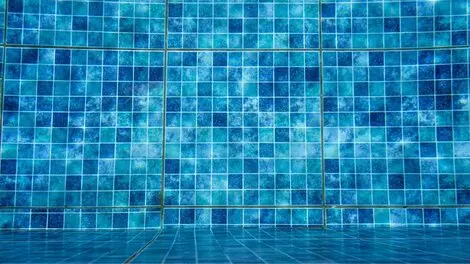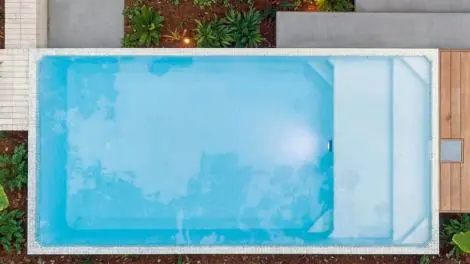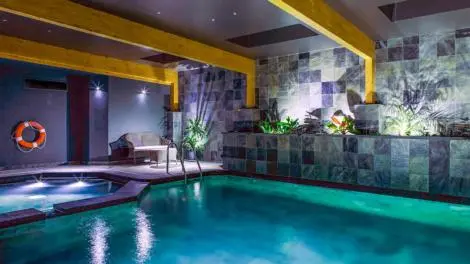Concrete or Fibreglass?
You’ve taken the first step and decided to build a pool – congratulations!
Now it’s time to decide what type of pool is right for you – concrete or fibreglass?
As fibreglass and concrete pool builders, we often get asked what’s better.
The truth is that there is no simple answer, as this varies from person to person based on various factors.
The question is, ‘What pool is right for you?’
Concrete Pools
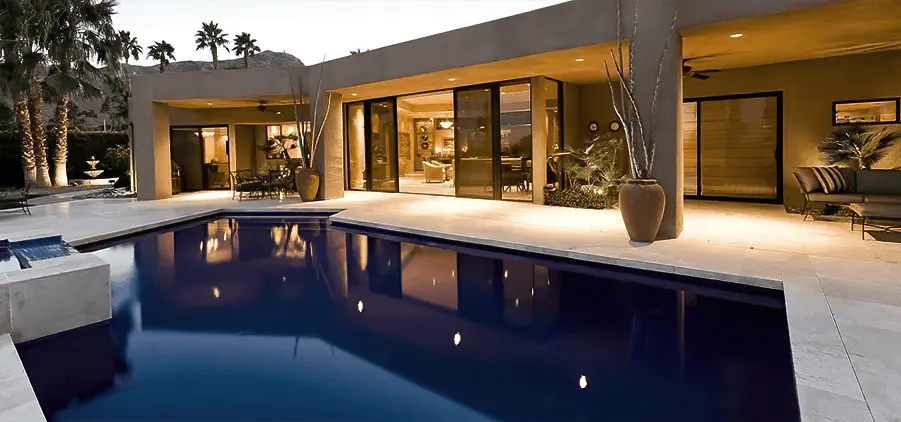
Advantages
- A concrete pool is entirely custom-built to suit your specific requirements.
- They are adaptable to the available space, providing solutions for all designs, lengths, widths and features.
- This includes colours, finishes, built-in spas, waterfalls, and features.
Disadvantages
- Require more maintenance.
- They do not have the same insulating properties as fibreglass and, therefore, are more expensive to heat.
- They are more expensive and take longer to build than fixed, fibreglass solutions.
Fibreglass Pools
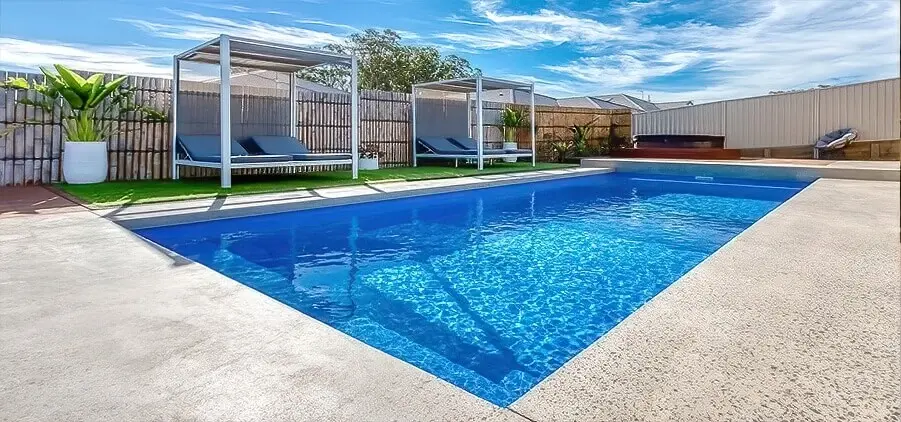
Advantages
- Less expensive and quicker to build than individual concrete designs.
- Fibreglass swimming pools resist algae growth and require less maintenance and chemicals due to their smooth surface. The smooth surface also resists scratching and damaging the skin.
- A fibreglass pool has good insulating properties, making heat easier and less expensive than a concrete pool.
- Do not require resurfacing.
- Warranty – There is a lifetime structural warranty with our fibreglass pool.
Disadvantages
- While there is an extensive range of shapes and sizes, you can’t have a custom shape to suit your block, which can limit your options.
Everybody loves having a swimming pool. It doesn’t matter whether you like relaxing by the poolside or prefer getting some exercise by swimming multiple laps.
With summer approaching again, now would be a great time to decide what kind of pool you want to install. You won’t be far into your research before it becomes clear that two pools are most popular among homeowners — fibreglass vs. concrete.
Each option has its upsides and drawbacks, which might leave you confused about the best one for your situation. Don’t worry because we have a detailed guide that pits the two side by side.
We will walk you through various factors you need to consider, and you can see whether concrete or fibreglass variants come ahead. Read on for more.
Why Install A Swimming Pool?
Even before we get into what kind of pool you need, some users might wonder why they need it. Here are some reasons to help you make up your mind.
Fitness And Health
Swimming is an excellent exercise for people of all ages; your entire body gets a workout. It relieves pressure points, which is why it remains a popular choice. Naturally, having your pool reduces travel costs to community pools, and you can work out whenever you get the time.
Great Family Time
Since a pool is suited for everyone, your family can socialise through games or fun activities in the water. It is an excellent opportunity for bonding amidst everyone’s hectic schedules.
Occupying Kids At Home
Typically, most concrete and fibreglass pools have safety features, and if your child isn’t too small, they can use the pool to keep themselves occupied. It is relaxing and fun to be in the water, so leave your kids with some select pool toys so you can get some quality time for yourself.
Cooling Down
Those living in warmer climates should always have a swimming pool since it is the quickest way to cool down. After a hard day at work, there is nothing more refreshing than taking a dip in cool waters, and having your private space to do the same is truly a privilege.
Future Investment
Trips to entertainment parks or resorts can end up being quite expensive. But, if you have a pool with all the latest features and customisations, you can save costs with all the pleasures readily available in your backyard.
Simple Pool Maintenance Tips
When you’re ready to invest in your new pool, here are some basic tips you can apply for a concrete or fibreglass option.
Scrub And Skim Frequently
A clean pool is a beautiful pool. But there will be dirt, dust and other undesirables accumulating daily. Putting in the effort to skim and scrub the surfaces will leave you with an aesthetically pleasing pool to hang out at and even squeeze in some workouts in the process.
Shock Cloudy Pools
If the bacterial levels become too high, your pool water will turn murky. While shocking is usually reserved for public pools, your pool might need it too after you’ve hosted a party or had a busy summer season. Drastically increase the chlorine levels to help your pool regain its previous blueness.
Use Tennis Balls For Oil Absorption
Tennis balls in swimming pools usually mean that people are having fun. However, many homeowners leave them in the water to absorb unwanted oils. Once you’ve taken a dip, some residual body oils might get in the water, which affects clarity and quality over time. Using tennis balls can handle the situation cost-effectively.
Comparison Based On Factors
Initial And Lifetime Costs
Typically, we don’t recommend DIY-ing a fibreglass pool on your own, but some people still choose to do it. Installing the pool has some costs that might increase depending on whether you want additional features and what kind of landscape it is installed in.
The installation and manufacturing costs can quickly run to anything between $45,000 and $85,000. This budget is just an estimate and will vary based on how fancy you want the structure to be. In the long term, your expenses include electricity and chemicals for maintenance.
On the other hand, concrete pools can cost anything between $50,000 and $100,000 right up front. However, long-term maintenance costs are much higher here, with acid washing, energy use, and refinishing.
Thus, while there isn’t much difference in the initial costs for both, concrete pools cost a lot more in the long run. Therefore, fibreglass would be a more viable option financially.
Customisation Options
Fibreglass pools are usually created from pre-designed moulds and shapes. Hence, you’re limited in your options for establishing new patterns or going with different sizes. But outside this basic structure, you can customise the pool however you want, with tanning ledges, water features, colourful lights, tiles, and different finishes.
A concrete variant is a way to go if you’re in the market for an enormous pool as long as it is deep. It will cost you more per square foot, but you’ll still have the option to customise it in any way you see fit.
Time For Installation
Fibreglass pools are constructed off-site and then installed where you want them. Once transported to your backyard, this pool is almost ready for use. Though there isn’t any fixed time, usually you can access the pool in about two days.
Decking and patio generally take a couple of weeks, so the entire process gets capped at three to five weeks.
On the other hand, concrete pools take anything between three and six months to construct. This takes place on-site, and you have to look at your torn-up backyard all this while. Therefore, fibreglass pools are much preferable for minimising user hassle and discomfort.
Texture Of Interior Surface
Fibreglass pools come with an interior texture known as a gel coat, which is exceptionally smooth against the skin. Though tanning ledges and steps are specially designed to have anti-slip textures, you’ll find these aren’t rough.
Comparatively, concrete pools have a wide variety of rough interiors. Plaster is the roughest choice and can scrape your skin badly if you’re not careful. There are exposed aggregates like pebbles available. These aren’t as rough, but some hard bumps still make walking uncomfortable. Polished aggregates can remedy this situation.
Tiling is the smoothest surface you can get for your concrete pool but is by far the most expensive. Therefore, owners have to go out of their way to make these pools comfortable while no additional expense is required for fibreglass variants.
Durability
Fibreglass pools are incredibly durable, and the gel coat finish lasts long. Even if users opt for salt chlorine generators to ensure silkier water needs lower maintenance, there aren’t many problems. Fibreglass shells are impervious to the harmful effects of salt, so your pool stays as good as new.
Now, concrete pools are incredibly sturdy and long-lasting, too. Though all kinds of interior finishes are resistant to essential wear and tear from branches, pets, and toys, you’ll still need regular maintenance to be sure your pool retains its initial ease of use.
This includes replastering and replacing the tiles along the waterline. If you’re going with salt chlorine generators, then tile finishes are safe, but plaster finishes dramatically reduce life expectancy.
Regular Maintenance
Every pool needs maintenance, but hands-on approaches can get tiring for users. Therefore, they all prefer variants where minimum care assures optimised results. Comparing fibreglass and concrete pools, it becomes evident that the former comes out miles ahead.
You’ll see the water pH level is unaffected by gel coats; thus, you don’t have to put in acid to balance this. But you’ll need to check water chemistry every week instead. On the other hand, concrete is alkaline, affecting water pH levels. Thus, the daily addition of muriatic acid is a must.
The pool surface should be cleaned with steel brushes to prevent algae from growing at the bottom. If concrete pools aren’t regularly maintained with the strictest vigilance, you’ll notice how the water colour changes, and your pool starts to look like a pond.
Presence Of Algae
Fibreglass pools come with gel coats that are algae-resistant and smooth. Even the pores are microscopic, so there’s no chance of algae burrowing into the bottom of the pool. In contrast, concrete pools have several cavities and pores which invite algae. Thus, it would help to brush the pool at least once each week.
Electrical And Chemical Energy
There’s no need for additional electricity or chemicals to keep fibreglass pools in great shape. Hence, users’ time, energy, and money are much less, which tends to be a significant point in favour of this option.
As concrete is alkaline-based, the water pH levels are affected too. Accordingly, you must add acid at set intervals to maintain a balance. Money and time must be put aside for extra chemicals to kill algae that regularly grow in such pools. So, in terms of maintenance costs, concrete pools outstrip fibreglass ones.
Heating
Concrete pools don’t heat up quickly or retain heat like fibreglass variants. Since the liner and pool shell are made to ensure that heat absorption is lower, you’ll find that the water heats up quickly and stays warmer for a longer time.
As concrete absorbs heat, you need a pool heater to keep the water warm and maintain the concrete’s temperature. Naturally, this process is more expensive and time-consuming.
Lifespan
When it comes to the ultimate lifespan, the durability of these pools comes into play. Concrete options are more long-lasting, and your pool will work well for around 40 years without significant changes.
However, fibreglass options remain properly serviceable for 15 to 20 years. We might add that lifespan is only improved and drawn out by regular maintenance in both cases.
Value Of Resale
Realtors believe that fibreglass and concrete pools can increase the resale values of homes if they are correctly maintained. There has been much discussion about whether an inbuilt pool is preferred among buyers.
But, you’ll notice how homeowners view it more as an investment for a better quality of life than a mere financial expense. To that end, depending on the house’s location and the climate in that area, a pool could be a handy feature that drives up your property valuation.
Which Is Better Suited?
Now that we’ve run you through the factors you should consider while choosing between a concrete and fibreglass pool, you might wonder which suits your needs better. Go over the characteristics carefully and see whether your pool needs to fit your aesthetic senses or provide utility.
Some people like to customise their pools as an accessory to their luxurious properties. These pools also invoke a tropical feeling in the compound in specific cases. Others merely want it to fulfil the basic utility of relaxation and exercise. Low installation and maintenance costs become more critical than customisation options if that’s your case.
Still, we will give you a quick rundown of the factors here. For concrete pools, you need to start with a slightly higher budget. But you can customise its shape as you see fit. In the end, however, you’ll spend more time and money maintaining the pool.
This is right for you if you want a completely natural design and don’t mind rough surfaces against your skin.
Your budget is less than fibreglass options, but your pool size will be medium or small at most. You’ll have to find a design that suits you rather than creating a pool based on your specific plan. Installation and maintenance costs are relatively low, even when we see the long-term picture.
However, it would help if you put in a flex strength to protect the pool from constant vibrations in the ground. If you feel a fibreglass pool is better but already has a concrete variant, you can always install the former inside the existing structure.
Our Vinyl Liner Pools Good Choices?
Although we have focused on concrete and fibreglass options, a third variant is quickly becoming popular. Before installing your pool, it is only fair that you know all the choices you have. Thus, acquaint yourself with vinyl liner pools.
They help keep the pool clean and free from algae as well. Further, they are pretty customisable, too. You’ll find this pool type to be the ideal compromise between a concrete and fibreglass option. There are as many choices as concrete pools regarding sizes or shapes.
But, considering algae growth and how it feels against the skin, vinyl liner pools can match up to fibreglass choices.
Like all things, there are some drawbacks, too. These pools are light on the pocket regarding initial costs, but heavy maintenance is required over the years. Vinyl linings only last five to nine years, so maintaining the pool becomes a lifetime expense.
Since these aren’t as durable, you must be extremely careful during usage. A hard thump might end up causing damage to the surface. You’ll have to shell out nearly $4,500 every few years to refill and reline the pool.
Concrete Pool vs Fibreglass Pool
Ultimately, your pool choice depends on your expectations and how much you’re willing to spend. Most users want simple installations that are easy to use and don’t need too much maintenance. After all, getting a pool for relaxation only to spend more time keeping it clean and spending on utility bills is hardly the intelligent choice.
Hopefully, our guide will help you understand what lining is best for your house. Each choice understandably has its pros and cons, but fibreglass pools eventually stand out for their ease of use.
Having a new swimming pool is a fashionable choice for homeowners nowadays, and we hope you can spruce up your backyard, too. If you have any queries about the installation process, don’t hesitate to get in touch with our pool builder.
